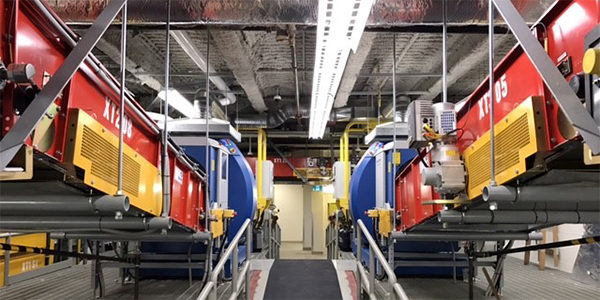Drive on

Victoria Airport in British Columbia, Canada, might not see the passenger numbers and luggage volume that large international hubs see on a daily basis, but it still has to keep its baggage handling and other systems running smoothly and efficiently. A few years back, it became clear to airport officials that it was time for a baggage system upgrade. So the airport company commissioned Auckland, New Zealand-based Glidepath, a manufacturer specializing in baggage conveying and parcel sorting equipment, to provide a new system.
It was evident from the start that the project would be particularly challenging from a design standpoint. The main issue was that the airport didn't have a lot of space to accommodate all the usual safety and sorting systems modules—from check-in through security screening to sorting. After carefully reviewing their options, the Glidepath engineers set to work designing a compact, tightly integrated system that could fit and function within a very limited footprint.
The new system, which can handle 750 pieces of luggage per hour, is made up of 85 conveyors with a total length of 250 meters (820 feet). It comprises two in-line screening CT machines, two decision points for sortation, and two separate infeed lines. It has four-way sorters, spiral power curves, bag alignment devices, a "luffing" conveyor, and Glidepath's ploughs and power curves.
To power all this equipment, Glidepath turned to Nord Drivesystems, a Bargteheide, Germany-based company that specializes in custom drive technology for airport applications. Nord helped its client choose and commission products to network all of the components together and allow remote monitoring of all the devices in the field, ensuring a fast and safe installation.
Today, all drive tasks are carried out by IE4 AC (alternating current) vector drive motors from Nord. Each drive unit consists of an IE4 permanent-magnet synchronous motor, a motor-mounted Nordac Flex frequency inverter, and a two-state gearbox. The hollow-shaft gearboxes are secured on the drive axis with a Gripmaxx bushing. This attachment allows for safe, easy-maintenance fitting without keys.
The drive systems take on various tasks at the conveyor modules, according to Nord. For instance, they move luggage at different speeds from one belt to the next. They also ensure accurate height adjustment when conveying diagonally.
The drive systems are designed to deliver energy efficiencies in partial load range and at low speeds, which are common in airport baggage handling applications. The frequency inverters are configured with plug-in connectors for power, communications, encoders, and sensors. They also feature an internal ethernet/IP interface, which enables remote monitoring of the applications. This is especially important in airports, where a breakdown in a single component can result in a backlog and unacceptable delays.
According to Jason Williams, project engineer at Glidepath, the pluggable drives saved Glidepath valuable time during installation and commissioning by connecting field devices directly to the frequency inverters. For the Victoria Airport project, the new baggage handling system required five different gear ratios with 90-odd motors in total and three different motor sizes. The ethernet communications provided seamless monitoring of connected sensors and actuators. "The real advantage," said Williams in a statement, "[is that] the drives support high-speed ethernet, which allows for reliable bag tracking on our system."
Related Articles

Copyright ©2024. All Rights ReservedDesign, CMS, Hosting & Web Development :: ePublishing